In Part 2 of this series on revelation, we will closely examine the Book of Mormon. If you have not read Part 1 of this series, I highly recommend that you do so before reading this post (you can read it here).
In the final month of my mission, I spent a lot of time studying with two young catholics who were seriously looking into the Book of Mormon claims. One night we came across the 3rd Nephi chapters where Jesus is teaching the Nephites. As we read the chapters, they instantly recognized the teachings and the language of the Bible (specifically the King James Version). They were very curious as to how the same language and phrases ended up in the Book of Mormon if it was truly a literal translation of the plates by Joseph Smith. They told me that if I really understood how the Bible was put together, I would understand how odd it was to find the same language in the Book of Mormon. I had no answer to their questions and began my search. This post would be my answer to those two young men I met almost 16 years ago. By no means is it an easy, closed-book, simple answer. Some of the questions that this post will bring up will never be answered in my own mind.
“First, Joseph Smith did not fabricate the Book of Mormon or falsify its claims. Second, in producing this sacred scripture from ancient records by the “gift and power of God,” translator Joseph Smith left traces of his environment on the English translation. To me those are two essential realities – the first an imperative of spiritual faith, the second an imperative of earthly evidence.” (Dr. D. Michael Quinn, Early Mormonism and the Magic World View, note 105, pg 354)
“Traces of his environment” is a very interesting thing to say. How much of his environment influenced Joseph’s work? In order for us to understand what the traces are and where they came from, we need to understand how the translation took place. When we use the word “translate”, immediately images come to mind of a person studying text and then dictating (or writing) what that text says. As a result, LDS artwork depicting the translation looks mostly like this:
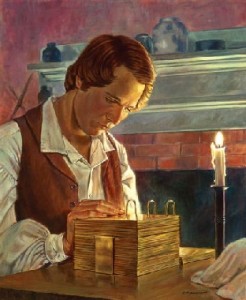
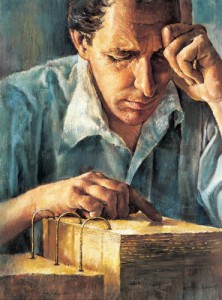
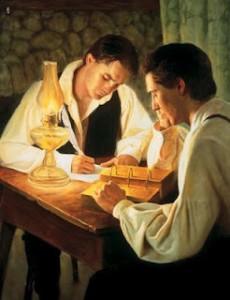
The above artwork concludes that Joseph looked at the plates to literally translate what was written on them. This might not seem like a big deal to most LDS members, and a lot of LDS members probably think these are accurate portrayals of the translation. The problem is that this is not the way it happened at all. Dr. Richard Bushman, author of Rough Stone Rolling, said:
I will begin by saying that we still have pictures on our Ward bulletin boards of Joseph Smith with the Gold Plates in front of him. That has become an irksome point and I think it is something the church should pay attention to. Because anyone who studies the history knows that is not what happened. There is no church historian who says that is what happened and yet it is being propagated by the church and it feeds into the notion that the church is trying to cover up embarrassing episodes and is sort of prettifying its own history. So I think we should just stop that immediately. I am not sure we need a lot of pictures of Joseph looking into his hat, but we certainly should tell our children that is how it worked. It’s weird. It’s a weird picture. It implies it’s like darkening a room when we show slides. It implies that there is an image appearing in that stone and the light would make it more difficult to see that image. So, that implies a translation that’s a reading and so gives a little clue about the whole translation process. It also raises the strange question, what in the world are the plates for? Why do we need them on the table if they are just wrapped up into a cloth while he looks into a seer stone? (FAIR Conversations podcast with Blair Hodges; Dr. Richard Bushman, part I, 47:46)
In my opinion, these images need to be thrown out of all the church material, including church web sites and videos. When we look at how the translation process really happened (pictured below), we can see that it is far from a typical word-for-word translation.
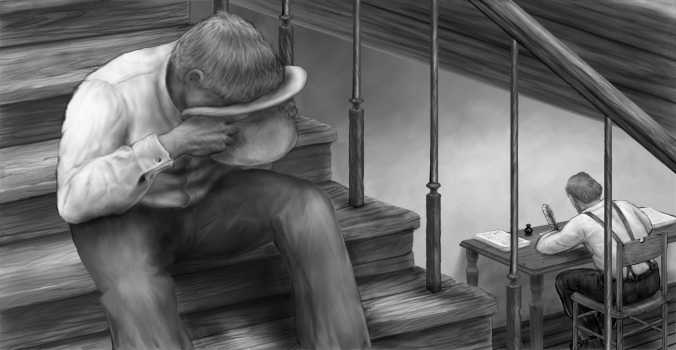
Joseph Smith looking into a hat at a seer stone dictates to Oliver Cowdery The Book of Mormon
So we have Joseph looking into a hat at a seer stone and dictating. The plates were always covered, and there are accounts that sometimes they were not even in the same room with Joseph. I, personally, would call his method “revelation” or “inspiration” instead of translation. This method of looking into a hat at a seer stone lends itself to more of “traces of his environment” and/or anachronisms making it into the pages of The Book of Mormon than a direct translation would (i.e. steel, horses, elephants, cattle, asses, oxen, sheep, swine, goats, brass, chains, iron, chariots, barley, passages from his copy of the KJV of the Bible).
So what was his environment? What things surrounded him and molded him as a person? The Bible, his parents, church revivals, the mystical, literature like View of the Hebrews, and I’m sure many other things shaped his environment; but for now, this is more than enough to dissect.
The Bible: Some passages from The Book of Mormon are identical, word for word, to passages from the King James Version (Isaiah, Matthew, etc.). There are also some similar story lines (i.e. Paul’s conversion compared to Alma’s conversion). So did Joseph copy those Bible passages? When Brant Gardner, author of The Gift and Power: Translating the Book of Mormon, was a taking a Greek class at BYU, the students were given a passage from Matthew to translate. Once the students recognized that it was a Bible passage, they wrote it out using what was familiar to them – the KJV vernacular.
Parents: Joseph Smith Sr. had a vision of a tree life very similar to the vision that Lehi had (found in 1 Nephi 8). According to Lucy Mack Smith, Joseph Smith Sr. had this vision in 1811 in Lebanon, New Hampshire:
- I thought…I was traveling in an open, desolate field, which appeared to be very barren. As I was thus traveling, the thought suddenly came into my mind that I had better stop and reflect upon what I was doing, before I went any further. So I asked myself, “What motive can I have in traveling here, and what place can this be?” My guide, who was by my side, as before, said, “This is the desolate world; but travel on.” The road was so broad and barren that I wondered why I should travel in it; for, said I to myself, “Broad is the road, and wide is the gate that leads to death, and many there be that walk therein; but narrow is the way, and straight is the gate that leads to everlasting’ life, and few there be that go in thereat.”
- Traveling a short distance farther, I came to a narrow path. This path I entered, and, when I had traveled a little way in it, I beheld a beautiful stream of water, which ran from the east to the west. Of this stream I could see neither the source nor yet the termination; but as far as my eyes could extend I could see a rope running along the bank of it, about as high as a man could reach, and beyond me was a low, but very pleasant valley, in which stood a tree such as I had never seen before. It was exceedingly handsome, insomuch that I looked upon it with wonder and admiration. Its beautiful branches spread themselves somewhat like an umbrella, and it bore a kind of fruit, in shape much like a chestnut bur, and as white as snow, or, if possible whiter. I gazed upon the same with considerable interest, and as I was doing so the burs or shells commenced opening and shedding their particles, or the fruit which they contained, which was of dazzling whiteness. I drew near and began to eat of it, and I found it delicious beyond description. As I was eating, I said in my heart, “I can not eat this alone, I must bring my wife and children, that they may partake with me.” Accordingly, I went and brought my family, which consisted of a wife and seven children, and we all commenced eating, and praising God for this blessing. We were exceedingly happy, insomuch that our joy could not easily be expressed.
- While thus engaged, I beheld a spacious building standing opposite the valley which we were in, and it appeared to reach to the very heavens. It was full of doors and windows, and they were filled with people, who were very finely dressed. When these people observed us in the low valley, under the tree, they pointed the finger of scorn at us, and treated us with all manner of disrespect and contempt. But their contumely we utterly disregarded.
- I presently turned to my guide, and inquired of him the meaning of the fruit that was so delicious. He told me it was the pure love of God, shed abroad in the hearts of all those who love him, and keep his commandments. He then commanded me to go and bring the rest of my children. I told him that we were all there. “No,” he replied, “look yonder, you have two more, and you must bring them also.” Upon raising my eyes, I saw two small children, standing some distance off. I immediately went to them, and brought them to the tree; upon which they commenced eating with the rest, and we all rejoiced together. The more we ate, the more we seemed to desire, until we even got down upon our knees, and scooped it up, eating it by double handfuls.
- After feasting in this manner a short time, I asked my guide what was the meaning of the spacious building which I saw. He replied, “It is Babylon, it is Babylon, and it must fall. The people in the doors and windows are the inhabitants thereof, who scorn and despise the Saints of God because of their humility.”
- I soon awoke, clapping my hands together for joy.
This account was told by Lucy Mack Smith publicly 15 years after the Book of Mormon had been published. Even though the actual dream took place 19 years prior to the publishing, her public account of the dream could have been influenced by her reading of the Book of Mormon. In any case, there was a dream of a tree with fruit.
View of the Hebrews: This book, written by Ethan Smith, was published in 1823 (The Book of Mormon was 1st published in 1830). The thesis behind this book was that the Native Americans were descendants of the 10 lost tribes of Israel. B.H. Roberts (March 13, 1857 – September 27, 1933), a seventy in the church, produced a special report listing 18 points of comparisons between View of the Hebrews and The Book of Mormon. Some of his points (and additional points) are listed below (credit to Brent Perkins for gathering these):
- The material in Ethan Smith’s book is of a character and quantity to make a ground plan for the Book of Mormon. It supplies a large amount of material respecting American antiquities leading to the belief that civilized or semi-civilized nations in ancient times occupied the American continents.
- It not only suggests, but pleads on every page for an Israelite origin of the American Indians.
- It deals with the destruction of Jerusalem and the scattering of Israel, as does The Book of Mormon.
- It emphasizes and uses much of the material from the prophecies of Isaiah, including whole chapters, as the Book of Mormon does.
- It deals with the future gathering of Israel and the restoration of the Ten Tribes, as the Book of Mormon does.
- It makes a special appeal to the Gentiles of the United States to become the nursing fathers and mothers unto Israel in the New World, even as the Book of Mormon does, holding out great promise to the great Gentile nation that shall occupy America if it acquiesces in the divine program.
- It holds that the peopling of the New World was by migration from the Old, the same as does the Book of Mormon. It takes its migrating people into a country where “never man Dwelt,” just as the Book of Mormon takes its Jaredite colony into “that quarter where there never has man been.” In both cases the journey was to the northward; in both cases the colony entered into the valley of a great river; they both encountered seas of “many waters” in the course of their journey; in both cases the journey was a long one. The motive in both cases was the same – a religious one.
- Ethan Smith’s book supposes that his lost tribes divide into two classes: the one fostering the arts that make for civilization, the other followed the wild hunting and indolent life that ultimately led to barbarism, which is just what happens to the Book of Mormon peoples.
- Long and dismal wars break out between Ethan Smith’s civilized division and his barbarous division. The same occurs between Nephites and Lamanites, divisions drawn on the same lines of civilized and barbarous in the Book of Mormon.
- The savage division utterly exterminates the civilized in Ethan Smith’s book; the Lamanites, the barbarous division of the Book of Mormon, utterly destroy the civilized division – the Nephites.
- Ethan Smith’s book assumes for the ancient civilized people a culture of mechanic arts, of written language, of knowledge and use of iron and other metals, and of navigation. The Book of Mormon does the same for its civilized peoples.
- Ethan Smith’s book assumes a unity of race for the inhabitants of America – the Hebrew race – and no other. The Book of Mormon does the same.
- Ethan Smith’s book assumes that this race (save perhaps, the Eskimo of the extreme north) occupied the whole extent of the American continents. The Book of Mormon does the same for its peoples.
- It assumes the Indian tongue to have had one source – the Hebrew; the Book of Mormon makes the same assumption for the language of its peoples.
- Ethan Smith’s book describes an instrument found – a breastplate with two white buckhorn buttons attached, “in imitation of the precious stones of the Urim”. Joseph Smith used some such instrument in translating the Book of Mormon called Urim and Thummim.
- Ethan Smith’s book admits to the existence of idolatry and human sacrifice; the Book of Mormon does the same.
- Ethan Smith’s book extols generosity to the poor and denouncing pride as traits of the American Indian. The Book of Mormon does the same for its peoples.
- Ethan Smith’s book denounces polygamy. The Book of Mormon, under certain conditions, does the same as to David and Solomon’s practices.
- Ethan Smith’s book quotes Indian traditions of a “Lost Book of God” and the promise of its restoration to the Indians with a return of their lost favor with the Great Spirit. This is in keeping with the lost sacred records to the savage Lamanites of the Book of Mormon.
- Ethan Smith’s sacred book was buried with some “high priest, keeper of the sacred tradition”. The Book of Mormon’s sacred records were hidden or buried by Moroni, a character that corresponds to this tradition in the Hill Cumorah.
- Ethan Smith’s book describes extensive military fortifications linking cities together over wide areas of the Ohio and Mississippi valleys, with military observatory or “watch towers” overlooking them The Book of Mormon describes extensive fortifications erected throughout large areas with military “watch towers” here and there overlooking them.
- Ethan Smith’s book describes sacred towers or “high places” in some instances devoted to worship, in other cases to idolatrous practices. The Book of Mormon also has its prayer or sacred towers.
- Part of Ethan Smith’s ancient inhabitants effect a change from monarchial governments to republican forms of government; Book of Mormon peoples do the same.
- In Ethan Smith’s republics, the civil and ecclesiastical power is united in the same person. This was a practice also with Book of Mormon people.
- Some of Ethan Smith’s peoples believed in the constant struggle between the good and bad principles by which the world is governed. Lehi, first of Nephite prophets, taught the existence of a necessary opposition in all things – righteousness opposed to wickedness, good to bad, life to death, and so following.
- Ethan Smith’s book speaks of the gospel having been preached in the ancient America; the Book of Mormon clearly portrays knowledge of the gospel had among the Nephites.
- Ethan Smith gives, in considerable detail, the story of the Mexican culture-hero Quetzalcoatl—who in so many things is reminiscent of the Christ. The Book of Mormon brings the risen Messiah to the New World, gives him a ministry, disciples, and a church.
It should be noted that it is easy to make parallels to fulfill one’s purpose, so one must keep an open mind when looking at parallels. But also just as important, one must ask how much influence do these parallels have?
In addition to the many instances of the human touch that are evident in the Book of Mormon, it’s equally important to note the instances of inspiration despite man’s shortcomings. Let me focus on some items from the Book of Mormon that would be considered “bull’s-eyes” because they point to the Book of Mormon as being an ancient text. I’m not trying to prove anything to anyone, nor do I think you should put your faith in things like these examples – there are arguments even against these bull’s-eyes.
1. Geography: Lehi’s journey out of Jerusalem takes them to the land named Nahom (most likely following the frankincense trails in the northern part of Yemen). In today’s world, this place is called Nahem in the country Yemen. Nahem or Nahom is where they buried Ishmael. Usually Lehi named things during his journey but in this case this land is already named. In Arabic or Hebrew the consonants are stressed if you are concerned about the spelling, vowels in Hebrew are spoken but not written. So what does the root N H M mean? It has different meanings. In South Arabian, the root NHM is related to stone cutting. The Hebrew root NHM, which is also found in the Bible, relates to sorrow, hunger, consoling and mourning appropriate when used to discuss a burial. And yes there is an ancient burial ground there. Shown in this image is an altar with the letters NHM inscribed on it. Arguably, there isn’t a way that Joseph could have known about the location of this place.
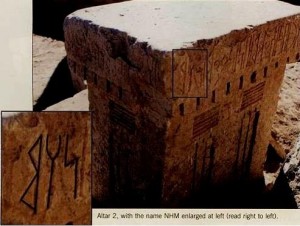
Lehi then goes east to the land they named Bountiful because it was very green and lush. This is where Nephi builds the ship that would carry them to the New World. In Joseph’s day or even a century after, it seemed unreasonable that such a place (green and lush) could exist in the barren Arabia. However, there is a spot in the peninsula that is east of Nahom that is green and lush and that fits Nephi’s description. The two places Nahem and Bountiful and their relationship is fairly precise rather than a general area.
2. Pahoran: In Akkadian, paḫāru means potter(1). The same is true in Aramaic (Daniel 2:41). In Akkadian, the word also stands as a personal name: Paḫāru (1). As a verb, paḫāru also means to “to assemble, congregate, muster”, especially for military purposes (1). Although Pahoran seems to be Egyptian in origin, a Semitic origin can’t be ruled out either(2). Sources:
(1)The Assyrian Dictionary of the Oriental Institute of The University of Chicago, p, pg 22-24.
(2) H. Nibley, “Proper Names In The Book of Mormon,” An Approach To The Book of Mormon, www.maxwellinstitute.byu.edu http://maxwellinstitute.byu.edu/publications/books/?bookid=60&chapid=605
3. Chiasmus: In poetry, a chiasmus is a reversal in the order of words in two otherwise parallel phrases. You probably have read millions of these to your kids while reading Dr. Seuss. This is also used as a poetical structure in some ancient writings from the Middle East and Greece.
Here is an example from Isaiah:
- (a) Make the HEART of this people fat,
(b) and make their EARS heavy,
(c) and shut their EYES;
(c’) lest they see with their EYES,
(b’) and hear with their EARS,
(a’) and understand with their HEART,
and convert [return], and be healed. (Is. 6:10)
And here is an example from the Book of Mormon (Mosiah 3:18-19):
- (a) They HUMBLE themselves
(b) and become as little CHILDREN
(c) believing that salvation is in the ATONING BLOOD OF CHRIST;
(d) for the NATURAL MAN
(e) is an enemy of GOD
(f) and HAS BEEN from the fall of Adam
(f’) and WILL BE forever and ever
(e’) unless he yieldeth to the HOLY SPIRIT
(d’) and putteth off the NATURAL MAN
(c’) and becometh a saint through the ATONEMENT OF CHRIST
(b’) and becometh as a CHILD
(a’) submissive, meek and HUMBLE.
The question I would ask my readers is how different would the Book of Mormon be if the “translator” had not been familiar with the Bible? What if he didn’t live during a very religiously charged time? If the Book of Mormon were translated today, would the same anachronisms exist, or would there be different issues? How much of the stories would be different?
My brother Mike poses the perfect question: “Is it a paradox that an omniscient, omnipotent, omnipresent, & immutable God uses humans that are the antithesis of all those attributes to bring about His will and goodness into the world?”
In Part 3 we will go over the Book of Abraham.

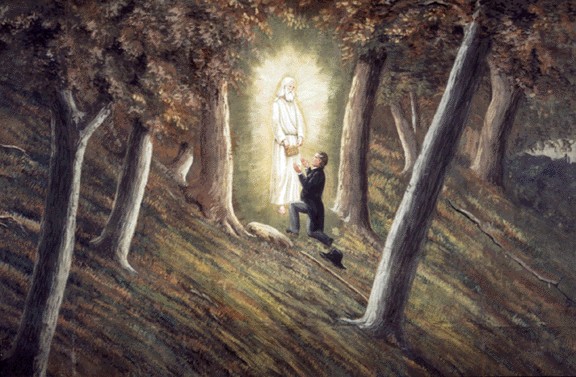



Good post Paul It seems more and more likely to me that in Joseph Smith’s translation he inserted aspects of his own experiences, as that was the best way he knew how to explain the revelation/translation that he was receiving. That’s where the phrase form Moroni on the title page comes in play, “And now, if there are faults they are the mistakes of men; wherefore, condemn not the things of God, that ye may be found spotless at the judgment-seat of Christ” I have definitely felt the spirit while reading the Book of Mormon which helps me to know it is of God.
With respect to the anachronisms in the Book of Mormon and the parallels with the View of the Hebrews, I can honestly admit that there are some questions there. I don’t have sufficient answers for them either. But, on the other hand, there are dozens of items that in 1830 were anachronisms that have since been discovered that support the Book of Mormon. Anachronisms that would have been impossible for Joseph Smith to guess. Critics of the Book of Mormon don’t have any good answers for those either. Instead, they kind of ignore them and focus on the unanswered questions.
My attitude with all of these is that the Lord left enough ambiguity and question to require faith. If there were incontrovertible evidences found, faith would no longer be as necessary for believing in the Book of Mormon. As it stands, I see enough there to support it though so that we as believers aren’t completely following an unsustainable theory.
Thanks Cody for your comments. I think it is important to recognize both sides and that’s why I put in the bulleyes. Fair and balanced right? 😉 there are some things in the post where I will never have an answer to simply because I wasn’t there but I’m ok with anything that gives us value.
Another unanswered question… why did we even need the plates? It seems like it was a huge pain for the prophets of The Book of Mormon to write, keep, carry, protect and finally bury the plates, just to have Joseph freelance with a seer stone.
To me it’s obvious why we needed the plates. For witnesses. You have the three that heard the voice of God when they were being presented the plates by an angel. This provided a legally sufficient number of witness and there was a definite divine nature to their experience so as to refute any claims that Joseph Smith created the gold plates himself. Then, you have the 8 witnesses that saw, felt, and handled them, but without the divine aspect. They, again, are more than enough legally to testify of the existence of such plates. In addition to them we have others that were allowed to see the plates, like sister Whitmer, for example.
Had the Lord just given Joseph the seer stone and no plates, the whole story would lose a massive amount of credibility.
Sorry, that sounds rude. I should have omitted the word obvious. I didn’t mean it to be condescending at all.
Ha ha all good Cody – I was referring to why we need the plates for the translation.
Perhaps they were a confimation for Joseph. A token of evidence for him.
Jeff I could see them being used as some sort of object of inspiration.
Doctrine and Covenants Section 7 speaks of Joseph translating “a version of the record made on parchment by John and hidden up by himself.”
Joseph Smith never had this parchment, yet he calls it a translation. Joseph did not have any of the extant Hebrew nor Greek texts when doing his “Bible Translation.”
This points to the fact that Joseph’s definition of “translation” is not what we think of in the academic sense of the term. It is definetly much looser. For that reason I agree with Paul’s assessment of calling the Book of Mormon “revelation.”
I don’t think that they would be a confirmation to Joseph at all. He saw and spoke with God and Christ and multiple angels by that point. “What greater witness can you have…”? Joseph never seemed to focus on physical things as evidence of God; like Paul points out, he was influenced by many things; I would like to see a list of things that influenced his beliefs and things he considered evidence that God lives (other than the fact that he spoke with him).
I don’t follow your logic Jon
I think he is saying Joseph didn’t need the plates as a witness because he already saw God and Jesus. Right Jon?
Jeff,
My last lesson that I gave to the YM was on Joseph’s use of the seer stone in the Book of Mormon translation. Bishop as well as my two counselors asked that I give a “Part II” to the lesson.
The second part is going to dive into why Joseph even needed the plates. One hypothesis is what I think you were articulating; correct me if I am wrong. The plates needed to be there to witness to Joseph and others that he was producing a real historical record. Another hypothesis correlates with the idea of electrical induction. The spinning magnet in the generator never touches the coils, but it needs to be there in order to produce the energy.
I think we are free to hypothesize as Joseph never provided any evidence as to why the plates needed to exist at all.
Cody I have been thinking a lot about what you said about faith. I think faith is still required for the Bible even though we know there was a Paul, Peter, James, names of cities, etc. We put faith in the lessons that are taught there even though we know the people and places existed. The stories might be incomplete and there are biases in those that translated, copied and told the stories in the Bible, but overall we have faith in the message. I would prefer to have faith in something that is incomplete or unexplained, but I’ll personally put my faith in the underlined message of the BOM. I don’t know if that’s a cop out but for me, right now that’s what works.
As we read the chapters, they instantly recognized the teachings and the language of the Bible (specifically the King James Version).
Paul, this statement seems a bit problematice as those in Argentina would not have been reading the King James Version, but rather the Reina Valeria.
They spoke english and I was training a greeny at the time so we had the spanish and english scriptures out. So after they recognized the same tone, we went to the English versions of the Book of Mormon and the Bible KJV. I guess I could have explained that, but it seemed a little wordy.
The testimonies of the three witnesses and of the eight witnesses are somewhat problematic in that the original versions (diary accounts and statements made by the witnesses later in their lives) of their involvement with the plates are either contradictory to or differ significantly from present day accounts. The problem arises when one understands that some of the witnesses described their interaction with the plates as spiritual or visionary in nature rather than an actual hands on encounter. Most of the witnesses believed in a “second sight” ability–not uncommon for that era– and thus may have been more easily convinced that they had actually physically examined the plates, when in reality they may well have experienced this so-called second sight phenomenon and ascribed it to an actual event. Just saying.
Also, the veracity of the witnesses comes under scrutiny when one considers that all of them were either relatives or close associates of Joseph Smith. This doesn’t make for a strong or credible case, any way you look at it.
Good post, Mike and Paul. Looking forward to some eye-to-eye discussions.
I remember hearing an explanation similar to this growing up (that it was more of a revelation than translation) and didn’t know why. I filed it away in my mind and forgot about it until I read Rough Stone Rolling and it clicked.
I want to attribute me hearing that explanation to dad but that doesn’t sound like something he would have said. And I didn’t have that many “doctrinal” conversations with him.
It also explains why Joseph was able to resume translation so fluidly after leaving the project. We always hear about how he never asked where they left off or for the scribe to read the last sentence. Makes a lot more sense why when you consider the real circumstances.
So he didn’t really have possession of the plates?
He really had the plates. He moved them from place to place. Emma describes moving them while she cleaned and how they felt.
When he “translated” the Book of Mormon, all the descriptions we have are of him looking at his dark brown seer stone (he had three seer stones). He wasn’t actually looking at the plates.
You knew that already from your reading of Rough Stone Rolling. You just forgot or you are pulling my leg.
Rough Stone Rolling is not my only source.
O.K.
You must be referring to Eber Howe’s citation of Isaac Hale in which Isaac is purported to have said that the plates were out in the woods while Joseph dictated the Book of Mormon. Or, it is Howe quoting Martin Harris in stating that the plates were sometimes not in the same room. Or, it is James Hunt citing Martin Harris stating that the plates “were hidden up to the Lord” while Joseph dictated them.
Did I guess right?
Yes– and Martin Harris interviewed by John A.Clark, 1828, in The Episcopal Recorder (Philadelphia), 5 Sept. 1840, 94 qtd. in Early Mormon Documents 3 + vols ed Dan Vogel, etc.
Oooh. I have been wanting those Dan Vogel books. I called Signature Books about a year ago and asked them what the difference was between what Dan Vogel produced and the Joseph Smith Papers. Once again, another set of books on my Barns and Noble “wish list”.
It musts be nice being retired and being able to read soooo much; super jealous. Your Mormon library must be getting super huge!
You might believe that God can reveal his truth book to the world, but how is it that a mans translation does not contaminate its since only men can translate, why then is it held in such esteem. Could it be delivered by angels already written like the Urantia book. Perhaps it is good to have faith, but revealed religion such as the Mormon faith that religious body of collective individuals, must have more faith in today’s confusion that Joseph Smith times could not of fore seened. Truth is evolutionary. We are never required to believe something at face value until proven by the authority of someone in superiority when we can have the testimony of truth that Jesus Christ promised to ubiquitously give to the entire planet, well at least the ones that desire to be more Christ like, and had good intentions. My opinion is not anti Mormon just anti religious in indoctrination. We need to be more spiritual, and unit with every search of truth where ever it takes us.
The testimony of all the witnesses are not problematic. The witnesses explained themselves time after time. I can’t remember who but he asked some people if they actually could see the pencil on the desk ….he actually saw the plates the way the people saw the pencil.
If it was a hoax, a lie, then why did the witnesses never deny what they saw and experienced. If it was a hoax it would have unraveled.
Emma Smith was asked if she really believed that Joseph was a Prophet of God, and other questions…..Emma said yes, Joseph was a true Prophet and there were days she wished that she did not know this and could deny it.
If it was a hoax then why would Emma put herself and the children through so much hardship and persecution, hiding and moving all the time. Not worth all that for a hoax, or to save face.